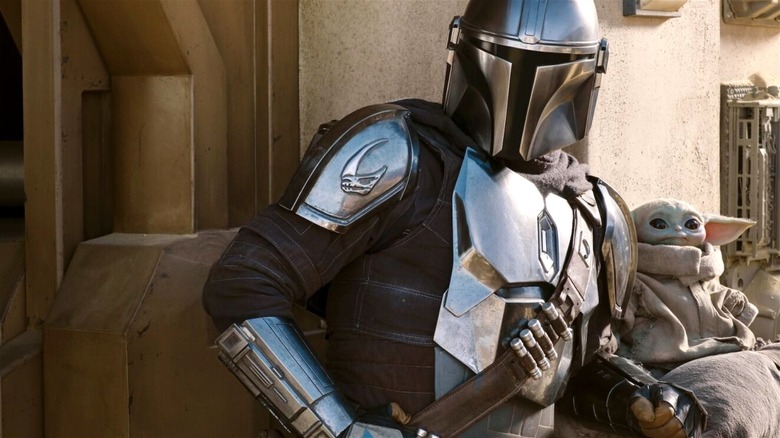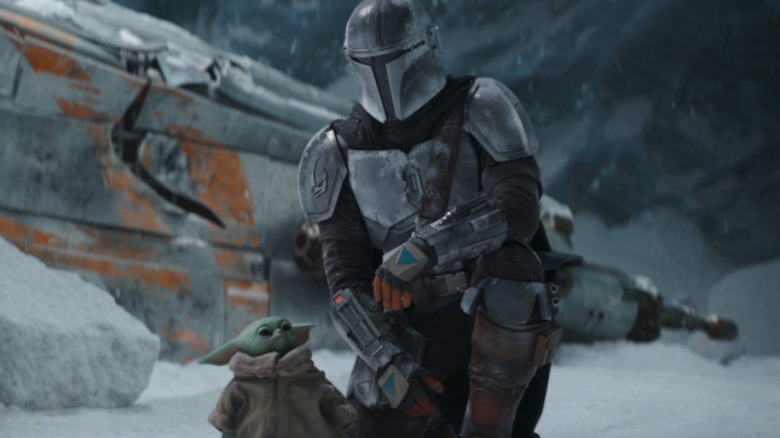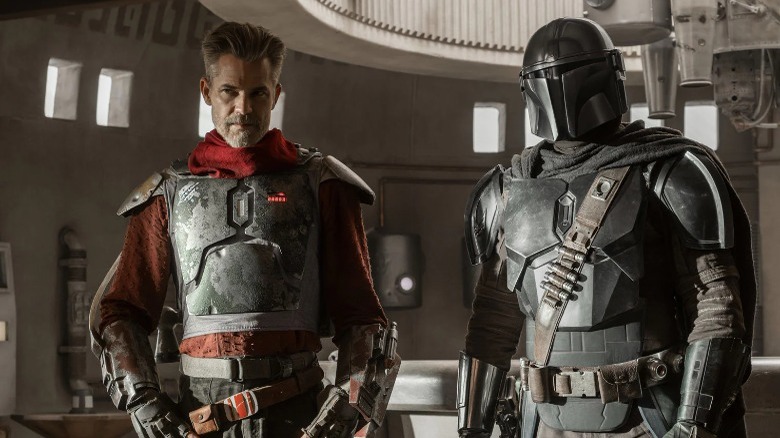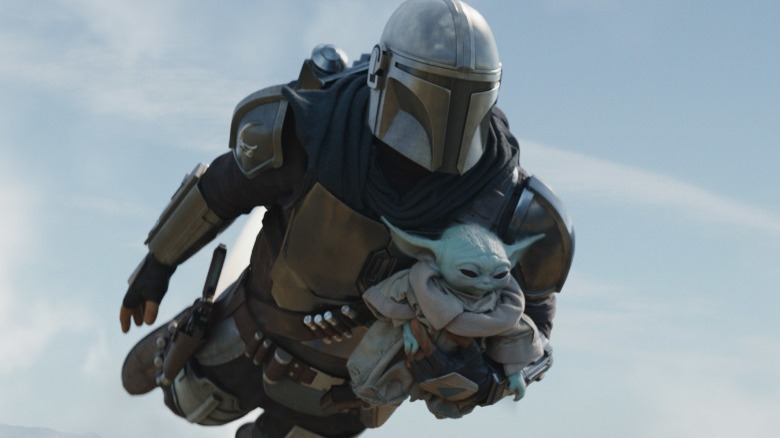
Over the course of 45 years and counting, "Star Wars" has evolved and branched into various shades of storytelling, from the gritty, grounded feel of "Andor" to the lore-heavy, adventure-of-the-week style narrative of "The Bad Batch." At its core, the franchise has always been heavily influenced by samurai films and space westerns, with George Lucas paying homage to the genres that shaped his artistic sensibilities. Although Lucas might not be directly involved with the acclaimed Disney+ series "The Mandalorian" — created and executive produced by Jon Favreau — the series proudly wears its samurai and spaghetti western influences on its sleeve. Playing out as a modern sci-fi with futuristic fantasy worldbuilding, "The Mandalorian" embraces its genre influences and subverts them to good measure, where bounty hunter Din Djarin (Pedro Pascal) plays the dual roles of a lone ranger and doting father figure, which situates him in the crossroads of questioning "the way."
The high-tech aspects of the show seem deliberately organic, functioning beyond the scope of aesthetic backdrops. Shot using The Volume to a significant extent alongside a mix of practical and digital effects, "The Mandalorian" succeeds in creating a world that feels modern while being steeped in old-fashioned sensibilities, echoing specific brands of honor, justice, and gunfighting. Although lightsabers make an appearance now and then, the heart of the action in "The Mandalorian" hinges on well-timed blaster shots and fast-paced shootouts, although Mando has to occasionally wrestle a Mudhorn or shoot ice spiders to save his kid from imminent danger.
Interestingly, in a world where space travel exists, some characters still embark on quests and partake in codes of honor reminiscent of the Old West and feudal Japan. One only has to trace the classic storytelling tropes/influences that the show incorporates within its high-tech world to understand its enduring appeal.
The Conflicted Warrior-Adorable Child Combo

When Din Djarin (Pedro Pascal) is first introduced in "The Mandalorian," he adheres to the straight-cut philosophy of pursuing bounties and capturing them, only using violence when necessary. Although emotionally detached from his way of life, Din is unquestioningly committed to what is expected of him as a bounty hunter and does not have the time or inclination to form attachments. However, when he and IG-11 track down The Child together, something shifts inside Din — it takes him a split second to shoot the droid and reach out to the baby who is supposed to be his target. Although Din still views Grogu as cargo at this point, this is the beginning of something wildly unexpected: A bond that will eclipse all moral baselines, codes of honor, and traditional obligations.
Although "The Mandalorian" references a wide range of media, its core premise is clearly inspired by Kazuo Koike and Goseki Kojima's manga series, "Lone Wolf and Cub." The six movie adaptations that the manga birthed follow executioner Ogami Ittō (Tomisaburo Wakayama), who has to go around decapitating heads and working as an assassin while protecting his kid, Daigorō. It is interesting to note that the 2002 reimagined sequel recontextualizes the series in a post-apocalyptic setting with cybernetic bodyguards, edging closer to the inspirations that "The Mandalorian" retrofits into its central premise.
By positioning Din as someone initially driven by the tenets of "the way," the show adds greater emotional weight to his decision to protect Grogu at the risk of being othered. The more time Din spends with the child, the more emotionally vulnerable he becomes — Grogu's presence opens up Din's vision of the world, as he learns more about those whose warrior codes diverge from his own.
The Old West And Samurai Codes Of Honor

Apart from excelling in the trope of "hired assassin becomes a surrogate father to (seemingly) helpless baby," "The Mandalorian" pays homage to the Western genre, rather blatantly in season 2 with the Krayt dragon storyline in Mos Pelgo. Echoes of classic westerns like Howard Hawks; "Red River" and Sergio Leone's "Dollars Trilogy" are easy to pinpoint, with the incorporation of tropes including bounty hunter-team-ups and a lone figure challenging norms to fulfill an uncharacteristic role. There are even shot recreations to cement thematic inspirations, such as the shot of Mando standing in a doorway, gun in hand, with the desert in the backdrop, miming the ending of 1956's "The Searchers."
The show's Samurai influences can be traced back to Lucas' love for the genre, especially Akira Kurosawa's "The Hidden Fortress," which directly inspired the core structure of "Star Wars: A New Hope." This 1958 film also features a central trio who challenge authority and characters who embody codes of honor that clearly inspired the Jedi code (Obi-Wan Kenobi is meant to evoke General Rokurōta from Kurosawa's original). The Jedi code has obviously evolved with the franchise, making space for ambiguous moral stances and ways of existence that echo that of the ronin, who stray from codified paths and remain masterless, like in Kurosawa's "Yojimbo."
Kurosawa's influence on "Star Wars" as a whole is unprecedented, as various tenets of the director's body of work are hard-coded into the very identity of the franchise. "The Mandalorian" pays exclusive homage to "Seven Samurai," which champions the trope of assembled heroes working together to protect a vulnerable group. "Chapter 4: The Sanctuary" unravels in a similar fashion, where Din has to team up with Cara Dune (Gina Carano) to protect villagers from violent raiders.
Nostalgia Mingled With Modernity

Kurosawa's influence extends beyond his jidaigeki or ronin dramas, as the Rashomon effect seems to be consciously utilized to enhance stakes in "The Last Jedi," which offers three conflicting versions of the moment Luke confronts Ben. As points of view seep into perceptions of truth that tint reality, it influences our ideological stances that map our paths — this lends to Din's dedication to remain faceless, where revealing one's true identity is akin to a loss of honor. He believes this is the only way to be a Mandalorian, a point of view that is shattered when he meets the Nite Owls, with Bo-Katan and co. removing their helmets. Although Din flies around in his Razor Crest, he is rather closed to the diverse ways of life, despite hopping planets for quest purposes. Din often seems hopelessly out-of-sync with his surroundings, heightening his solitude and attachment to Grogu.
When Din learns about Grogu's past, he is clueless about most of Jedi history. Din does not know what happened during Order 66 or even understand what being a Jedi entails. However, instead of letting his ignorance get the better of him, he attempts to understand Grogu's origins. Yes, Din abides by certain honor codes that seem dated within the show's ruthless world, but he also understands when he must indulge in cold-blooded violence and when he must extend trust or mercy. Din needs to dig into the past — both Grogu's and his own — to chart their paths in the future, both in terms of the child's destiny and Din's identity as (and beyond) a Mandalorian.
"The Mandalorian" builds its dynamic worlds with state-of-the-art technology, but these modern elements mingle with a brand of nostalgia that elevates it beyond standard genre fare.
Read this next: 12 Star Wars Moments That Haven't Aged Well
The post The Mandalorian is the Most High-Tech Old-Fashioned Show, And That's Why It Works appeared first on /Film.
0 Comments